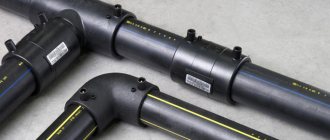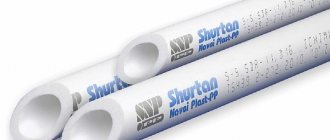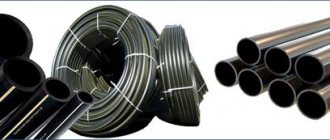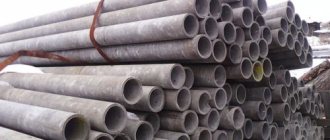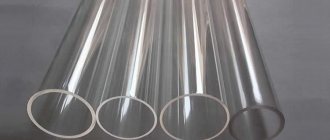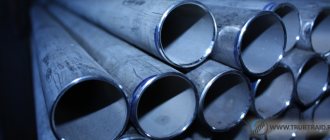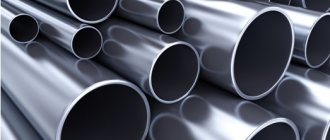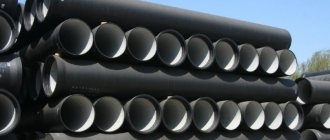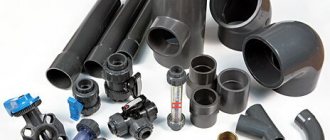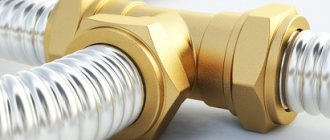Asbestos products have long been widely used. They are used in the industrial sector and construction. Asbestos-cement pipe 100 mm is the most common product option. Products with this diameter can be used to solve a variety of problems. In this article you will learn about the technical characteristics of products of the specified size and some options for their use.
Non-pressure asbestos-cement pipes
| nominal diameter, mm | Inner diameter, mm | Outer diameter, mm | Wall thickness, mm | Length, mm | Weight of 1 m of pipe, kg |
| 100 | 100 | 118 | 9 | 3950 | 6,1 |
| 150 | 141 | 161 | 10 | 3950 | 9,4 |
| 200 | 192 | 222 | 15 | 5000 | 17,8 |
| 300 | 274 | 308 | 17 | 5000 | 27,4 |
| 400 | 373 | 413 | 20 | 5000 | 42,5 |
| 500 | 512 | 25 | 5000 | 53,8 |
The pipes are equipped with asbestos-cement couplings.
Asbestos-cement pipes are often called asbestos-cement pipes or asbestos pipes.
Application of asbestos-cement non-pressure pipes: laying telephone and electrical cables, installing external pipelines of non-pressure sewerage, drainage collectors of reclamation systems, chimneys, air ducts and gas ducts, drainage through roads and crossings, instead of metal or wooden fence posts, to replace bricks when making holes and cellars, for covering the roofs of garages and industrial buildings (instead of reinforced concrete).
Produced in accordance with GOST 1839-80 (diameter 100-150), TU 5786-016-00281631-2006 (diameter 200-500).
Application and characteristics
To begin with, it is necessary to say that this material usually refers to several types of products. However, this article will consider products such as chrysotile cement pipe BNT 150 and the like, since old-style systems are practically no longer used anywhere. It is worth noting right away that new materials have begun to be used much more often than their predecessors.
A certificate of conformity must be present for each batch of such goods
Properties
- The main technical characteristics of asbestos-cement free-pressure pipes BNT 100 are that they are almost completely free from influence from stray currents . Therefore, they do not corrode and can be used in areas with high magnetic fields.
It is believed that polyethylene materials can replace BNT products, but in some industries and specific productions they cannot even be compared together, since stray currents have a certain effect on plastic
- It is also important to mention that, thanks to the material from which the asbestos-cement pipe is made, blockages almost never occur in it caused by the adhesion of various particles to its walls.
- It also needs to be said about the tropical properties of such systems . The fact is that an asbestos-cement pipe can withstand quite high temperatures, while having a minimal expansion coefficient.
Table of varieties of these types of materials indicating diameters, wall thicknesses and lengths of products
- Such products cannot withstand high pressure, both inside and outside . Therefore, the installation instructions do not recommend using them in areas with large external loads or in pressure systems.
Advice! All such products are created according to a specific GOST, which must be indicated in the labeling. At the same time, each specific batch must have a certificate of conformity, which should be checked upon purchase.
Using pipes as a kind of formwork in the manufacture of concrete piles
Application area
First of all, the chrysotile cement system is used for the manufacture of sewerage pipelines. It has proven itself especially well in places located near power lines or near railways. Moreover, its service life in these areas can be several times higher than that of structures made of other materials.
Creation of sewer systems that can last much longer and be used for waste materials with an acidic environment or other active reagents that are incompatible with metal
Also, such pipes are very often used to create chimneys or ventilation. It is worth noting that their price is slightly higher compared to old materials. However, it must be taken into account that in their manufacture they began to use a special mesh for reinforcement, and in some cases, a kind of polymer coating.
Advice! Some craftsmen refuse to use such materials because of their low strength, but in certain situations these pipes are suitable. They allow you to save not only on the frequency of system replacement, but also on the creation of protective boxes, which are sometimes simply necessary when working with PVC products.
A special coupling that is used to connect similar pipes during installation
Installation
It is worth noting that installing such pipes with your own hands is quite simple. In fact, they are assembled using special couplings with rubber seals. As a result, the system is completely sealed under low pressure.
Some types of such products are made with special grooves that serve to join the material, but then it is necessary to use a strictly defined brand of products and preferably from the same manufacturer
Special attention should be paid to the fact that all structures of this type have quite an impressive weight. Therefore, when using a pipe with a diameter of 200 or more, special equipment may be required.
Advice! To increase the level of sealing, some craftsmen use special compounds that are poured into the cracks of the joints. This is a pretty good practice, especially when connecting pipes at an angle or slope.
Recently, only couplings have been used during installation, since they do not limit the craftsmen in the process and can even create corner and inclined joints, which is sometimes very important, since it simplifies the process of digging a trench
Asbestos-cement pressure pipes
The working pressure of the pipes is 9, 12 atm.
| nominal diameter, mm | Inner diameter, mm | Outer diameter of the turned end, mm | Wall thickness, mm | Length, mm | Weight of 1 m of pipe, kg | |||
| VT-9 | VT-12 | VT-9 | VT-12 | VT-9 | VT-12 | |||
| 150 | 141 | 135 | 168 | 13,5 | 16,5 | 3950 | 15,2 | 17,9 |
| 200 | 196 | 188 | 224 | 14,0 | 18,0 | 5000 | 24,5 | 30,0 |
| 300 | 286 | 276 | 324 | 19,0 | 24,0 | 5000 | 47,4 | 57,9 |
| 400 | 377 | 363 | 427 | 25,0 | 32,0 | 5000 | 81,8 | 100,0 |
| 500 | 466 | 450 | 528 | 31,0 | 39,0 | 5000 | 124,0 | 151,0 |
The pipes are equipped with asbestos-cement couplings and rubber sealing rings.
Asbestos-cement pipes are often called asbestos-cement pipes or asbestos pipes.
Application of asbestos-cement pressure pipes: laying pressure networks for drinking and process water, pressure sewerage, reclamation systems, for drainage collectors, chimneys, air ducts, gas ducts, as casing pipes for various wells, for garbage chutes in residential high-rise buildings, foundations in wetlands, construction of wells , instead of metal or wooden fence posts, for installing water pipelines across roads and crossings.
Produced according to GOST 539-80 .
Asbestos-cement pipes for heating mains
Working pressure - 16 atm.
| Conditional bore, mm | Inner diameter, mm | Outer diameter of the turned end, mm | Wall thickness of the turned end, mm | Length of the turned end, mm | Pipe length, mm | Weight of 1 m of pipe, kg |
| 100 | 92 | 122 | 15 | 200 | 3950 | 12,5 |
| 150 | 130 | 168 | 20 | 200 | 3950 | 22,5 |
| 200 | 180 | 224 | 23 | 240 | 5000 | 38,3 |
| 300 | 272 | 324 | 30 | 240 | 5000 | 72,4 |
The pipes are equipped with asbestos-cement couplings and heat-resistant sealing rings.
Properties of pipes for heating mains:
- Asbestos-cement pipes are absolutely not susceptible to corrosion, and exposure to water (hot or cold) gives them additional strength.
- Asbestos-cement pipes are almost 3 times cheaper than metal pipes.
- No protection from stray currents or groundwater is required.
- Asbestos-cement pipes have a low thermal conductivity coefficient and do not require thermal insulation.
- The use of our pipes in heating mains ensures high reliability at water temperatures up to 130 °C.
- Costs for construction and installation work are reduced by 50-60%.
- The use of asbestos-cement pipes in heating mains can reduce the duration of construction, reduce the labor intensity of work and the need for construction equipment.
Parameters of asbestos-cement pipe: weight, length and diameter
Asbestos cement is fiber reinforced concrete. Drinking and technical pipelines are installed using asbestos-cement pipes. Also, this type of pipe is actively used for the construction of storm drains, pressure sewerage, free-flow sewerage, gas and stove heating chimneys.
Advantages of asbestos-cement pipes:
— resistance to low temperatures;
- resistance to rotting and corrosion;
- resistance to overgrowing.
How much do asbestos cement pipes weigh?
The theoretical weight of asbestos cement pipes is indicated in the tables below. The weights were calculated for a pipe moisture content of 15%. Using these tables, you can only determine the weight of standard asbestos-cement pipes.
Theoretical weight of one linear meter of type 1 asbestos-cement pipes:
Theoretical weight of one linear meter of type 2 asbestos-cement pipes:
Theoretical weight of one linear meter of asbestos-cement pipes of type 3:
Length of asbestos cement pipes
The length of the asbestos-cement pipe varies from 3.95 to 5 meters . In this case, the flow area has the following values: 150, 300, 100, 400, 200, 500 and 250 millimeters.
Diameters of asbestos-cement pipes
Asbestos-cement pipes and couplings are divided into two groups: pressure water pipes and non-pressure sewer pipes. For the manufacture of pressure water supply asbestos-cement pipes, GOST 539-59 is used. Non-pressure sewer asbestos-cement pipes are made in accordance with GOST 1839-48. The outer and inner diameters in millimeters of this type of pipe are indicated in the following tables.
Diameters of pressure water supply asbestos-cement pipes:
Diameters of free-flow sewer asbestos-cement pipes:
In addition to installing water pipelines, pressure water supply asbestos-cement pipes are also used for the installation of oil pipelines, gas pipelines and sewage systems. Free-flow sewer asbestos-cement pipes can be used for the construction of garbage chutes, drainpipes, chimneys, ventilation ducts, and telephone pipelines.
[content-egg module=GdeSlon template=compare]
Standard sizes
Asbestos cement product is a special type that uses asbestos to provide improved mechanical properties. Plain cement pipe often lacks tensile strength. Added asbestos fibers provide increased strength.
Asbestos pipe was primarily used in the mid-twentieth century. It was used less in the 1970s and 1980s, mainly because of the health risks to workers who fabricated and installed the pipe. Dust during cutting was considered especially dangerous.
According to GOST, such products come in the following parameters.
Crushing load, not less
Bending load, not less
The magnitude will be tested. hydraulic pressure
If the length is usually 3.95 or 5 meters, then choosing a product according to the cross-section is more difficult, since there are many more types:
100 and 150 mm - this diameter is ideal when you need to make ventilation or a water supply system to the house;
200 mm and 250 mm – a product used in organizing a network line;
Non-pressure asbestos-cement pipes
The pipes are equipped with asbestos-cement couplings.
Asbestos-cement pipes are often called asbestos-cement pipes or asbestos pipes.
Application of asbestos-cement non-pressure pipes: laying telephone and electrical cables, installing external pipelines of non-pressure sewerage, drainage collectors of reclamation systems, chimneys, air ducts and gas ducts, drainage through roads and crossings, instead of metal or wooden fence posts, to replace bricks when making holes and cellars, for covering the roofs of garages and industrial buildings (instead of reinforced concrete).
Produced in accordance with GOST 1839-80 (diameter 100-150), TU 5786-016-00281631-2006 (diameter 200-500).
Asbestos-cement pipes for heating mains
The pipes are equipped with asbestos-cement couplings and heat-resistant sealing rings.
Properties of pipes for heating mains:
- Asbestos-cement pipes are absolutely not susceptible to corrosion, and exposure to water (hot or cold) gives them additional strength.
- Asbestos-cement pipes are almost 3 times cheaper than metal pipes.
- No protection from stray currents or groundwater is required.
- Asbestos-cement pipes have a low thermal conductivity coefficient and do not require thermal insulation.
- The use of our pipes in heating mains ensures high reliability at water temperatures up to 130 °C.
- Costs for construction and installation work are reduced by 50-60%.
- The use of asbestos-cement pipes in heating mains can reduce the duration of construction, reduce the labor intensity of work and the need for construction equipment.
Advantages of asbestos-cement pipes for heating pipes:
- Cheap (3-4 times cheaper than metal ones).
- Durability (service life 40-60 years).
- Corrosion resistance (do not corrode, do not overgrow).
- Low thermal conductivity.
- No operating costs required.
- Easy installation.
Asbestos-cement pipes are often called asbestos-cement pipes or asbestos pipes.
The use of asbestos pipes for heating mains: in heating and hot water supply networks.
[content-egg module=GdeSlon template=compare]
Chrysotile based cement pipes
An alternative to asbestos-cement pipes are chrysotile-cement pipes. They are used mainly for transporting water. The main advantage is the absence of internal organic growths throughout the entire service life. The cost is about 300 rubles (chrysotile cement pipes 100 mm, length 3950 mm) for small wholesale purchases. These pipes are supplied in a wide range of couplings, which do not require special devices for installation and are characterized by low weight and ease of installation.
Chrysotile cement pipes
Chrysotile also has a silicate origin and a fibrous structure; it is often popularly called mountain flax due to the length of the natural fibers of the mineral, which give strength to concrete structures. Chrysotile is a type of asbestos that is known as white asbestos, which is light in weight.
Asbestos pipes based on chrysotile can be used for transporting hot water without an insulating casing, especially with additional heat treatment of technical pipe products at a temperature of 650-700 C, which reduces the thermal conductivity of chrysotile cement by 30%. We also note that upon contact with water, asbestos becomes denser and stronger, for this reason it is recommended specifically for transporting water.
Asbestos-cement pipe 100 mm: technical characteristics
Asbestos products have long been widely used. They are used in the industrial sector and construction. Asbestos-cement pipe 100 mm is the most common product option. Products with this diameter can be used to solve a variety of problems. In this article you will learn about the technical characteristics of products of the specified size and some options for their use.
Asbestos-cement pipe 100 mm: GOST 1839 80
In Soviet times, a state standard was developed, which asbestos pipe products had to comply with. According to GOST, products with an internal diameter of one hundred millimeters had an outer diameter of one hundred and 11.8 centimeters. This type of product was the most in demand. It was allowed to produce pipes of larger sizes only upon customer order.
The equipment is manufactured in two lengths: 2950 and 3950 mm. The wall thickness in both cases corresponds to 9 mm. The deviation in the outer diameter is up to 2.5 mm, and in the wall thickness - 1.5 mm. Discrepancies in length up to 50 mm are allowed.
The shape of the equipment should be cylindrical and straight. There may be slight deviation. If the length of the product is 2950 mm, it can be a maximum of 1.2 cm. The permissible deviation for pipes 3950 mm is 1.6 cm.
The product is waterproof. It is tested by hydraulic pressure. Its value should correspond to 0.4 MPa. For products belonging to the highest quality category, this indicator is 0.6 MPa. After testing, asbestos pipes should show no signs of liquid penetration.
Samples are also crush tested under ultra-humid conditions. A minimum 100 mm asbestos-cement pipe can withstand a load of 4508 N. For high-quality products, this figure is 5253 N.
Conclusion
We remembered only a small part of where this practical material can be used. Over a hundred years of operation, in one form or another, this type of product can be found almost everywhere, it enjoys well-deserved recognition among the people (read also the article “Vuctile Iron Pipes - Features and Application”).
Finished goods warehouse.
Did you like the article? Subscribe to our Yandex.Zen channel
